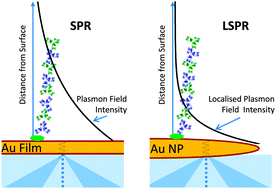
In this paper from University of Exeter, Thomas Read and co-workers determine the propagation of plasmon fields in biological media. They make as stack immunoglobulin molecules and determine the critical parameter (β for us who grew up with reading electron transfer literature) for a plasmonic gold surface and a gold nanoparticle. The numbers are 17.5 nm and 90 nm, respectively. As the number goes in the denominator in an exponential, this is a significant difference in the reach of the plasmon fields.
I find it enticing that, in a field dominated by physicists, a chemical approach using biomolecules is the experimentalists answer to measure the extent of the plasmon fields. By building a tower of molecules it is possible to see the step wise change in the read-out from the SPR platform. For a person outside the field, the paper contain an advert for the home-build LSPR platform the authors use in their experiments. The data from this set-up completely outshines the data from the commercial SPR platform.
If your curiosity has been aroused, the full paper is published in PCCP under the title:
Measurement of the localised plasmon penetration depth for gold nanoparticles using a non-invasive bio-stacking method
Thomas Read, Rouslan V. Olkhov and Andrew M. Shaw
DOI: 10.1039/C3CP50758K
by Dr Thomas Just Sørensen










